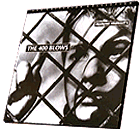

France film school
1959
bw 94 min.
Director: Francois Truffaut
CLV: $49.95 - available
1 disc, catalog # CC1316L
DVD: $39.95 - available
1 disc, catalog # FOU060
VHS: available from Home Vision Cinema

François Truffaut's first feature, The 400 Blows (Les Quatre cents coups),
was more than a semi-autobiographical film; it was also an elaboration of
what the French New Wave directors would embrace as the caméra-stylo
(camera-as-pen) whose écriture (writing style) could express the filmmaker
as personally as a novelist's pen. It is one of the supreme examples of
"cinema in the first person singular." In telling the story of the young
outcast Antoine Doinel, Truffaut was moving both backward and forward in
time-recalling his own experience while forging a filmic language that
would grow more sophisticated throughout the '60s.
The 400 Blows (whose French title comes from the idiom, faire les quatre
cents coups-to raise hell) is rooted in Truffaut's childhood. Born in Paris
in 1932, he spent his first years with a wet nurse and then his
grandmother, as his parents had little to do with him. When his grandmother
died, he returned home at the age of eight. An only child whose mother
insisted that he make himself silent and invisible, he took refuge in
reading and later in the cinema.
Like Antoine, Truffaut found a substitute home in the movie theater: He
would either sneak in through the exit doors and lavatory windows, or steal
money to pay for a seat. In The 400 Blows, Antoine and René reenact the
delinquency and cinemania of the young Truffaut and Robert Lachenay (who
was an assistant on The 400 Blows). Their touching friendship is captured
in René's unsuccessful attempt to visit Antoine at reform school.
And like Antoine, Truffaut ran away from home at the age of eleven, after
inventing an outrageous excuse for his hooky-playing. Instead of Antoine's
lie about his mother's death, Truffaut told the teacher that his father had
been arrested by the Germans. The recent revelation that Truffaut's
biological father-whom he never knew-was a Jewish dentist renders this
excuse especially poignant. His mother was only 17 when Truffaut was born;
at 18, she met Roland Truffaut, whom she married in 1933, and he recognized
the boy as his own. Antoine's uneasy relationship to his adoptive father
reflects that of the director. After young François himself committed minor
robberies, the senior Truffaut turned him over to the police.
It is not surprising that one of the dominant, although subtle, motifs
throughout Truffaut's work is paternity (nor that his entire career is
marked by filial devotion to mentors like Renoir and Hitchcock). In The 400
Blows, the class in English pronunciation revolves around a question that
can be articulated only with difficulty, "Where is the father?"-a phrase
that resonates both within the film (Antoine has never known his real
father) and in the director's life.
Antoine Doinel became a composite of two compelling individuals, Truffaut
and the actor Jean-Pierre Léaud. Out of sixty boys who responded to an ad,
the director chose the 14-year-old Léaud because "he deeply wanted that
role . . . an anti-social loner on the brink of rebellion." He encouraged
the boy to use his own words rather than sticking to the script. The result
fulfilled Truffaut's avowed aim, "not to depict adolescence from the usual
viewpoint of sentimental nostalgia, but . . . to show it as the painful
experience that it is."
Anticipating Truffaut's later preoccupation with the emotional nuances of
libidinal love, The 400 Blows is also a tale of sexual awakening: We see
Antoine at his mother's vanity table, toying with her perfume and eyelash
curler; later he is fascinated by her legs as she removes her stockings.
The stormy relationship of Antoine's parents-a constant drama of
infidelity, resentment, and reconciliation-foreshadows the romantic and
marital tribulations of Antoine himself throughout the Doinel cycle, and
offers compelling clues to decode the male protagonists of Truffaut's films
in general.
The last shot has been justly celebrated for its ambiguity. This brief but
haunting release from the harrowing experiences that fill the movie brings
Truffaut's surrogate self in direct contact with his audience-an intimacy
he was to pursue throughout his career. Truffaut's zoom in to freeze-frame
(more arresting in 1959, before this technique became a stock-in-trade of
television commercials) provides a mirror image of an earlier shot in the
police station. When Antoine is arrested for stealing a typewriter, he is
fingerprinted and photographed for the files. The mug shot is in fact a
freeze-frame that conveys the definitive and permanent way in which he has
been caught.
That The 400 Blows is a record-even an exorcism-of personal experience is
first alluded to in Antoine's scribbling of self-justifying doggerel on the
wall while being punished. On a larger scale, we can see the film as
Truffaut's poetic mark on the wall, or his attempt to even the score; by
the last scene, the sea washes away Antoine's footprints as the film
"cleans the slate"-although that final image remains indelible.
--Annette Insdorf
Annette Insdorf, author of Francois Truffaut and Indelible Shadows: Film
and the Holocaust, directs undergraduate film studies at Columbia
University.
CAST
Antoine Doinel Jean-Pierre Léaud
Madame Doinel Claire Maurier
Monsieur Doinel Albert Remy
René Bigey Patrick Auffay
Teacher ("Little Quiz")
Guy Decomble
Monsieur Bigey Georges Flamant
CREDITS
Dedicated to André Bazin
Directed by François Truffaut
Original story François Truffaut
Adaptation François Truffaut
& Marcel Moussy
Photography Henri Decae
Art direction Bernard Evein
Music Jean Constantin
Editor Marie-Josèph Yoyotte
Sound Jean-Claude Marchetti
ABOUT THE TRANSFER
The 400 Blows is presented in its original Dyaliscope aspect ratio of
2.35:1. This D1 digital transfer was created from the 35mm fine grain
master and the 35mm magnetic audio track at Teletota Labs, Paris.
Telecine supervisor: Maria Palazzola
Subtitling: Levana Skhedi, Modern Videofilm, L.A.





